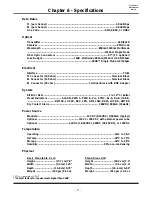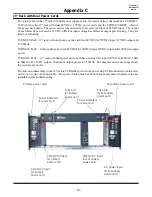
- 12 -
TC1631R/S
User's Manual
Rev. 1.6
Chapter 3 - Troubleshooting
General
Alarm conditions occur whenever an optical problem or "fault" condition is detected by the TC1631.
All LEDs are Off
If no LEDs are lit on the unit, check the DC power supply, terminal block connector plug, change to alternate
power jack on the rear panel, fuses A and/or B indicated on page 16, and/or the power source. If the problem
persists, contact the Technical Support Department at TC Communications, Inc.
Alarm LED
When an alarm condition is detected, the Alarm LED will flash. The following fault conditions will cause
the alarm to be triggered:
1.
Optic signal lost from optic "RxA" or "RxB" (for optical redundant models only).
2.
Optic signal is marginal, which causes invalid data packets to be received; the "SYNC" LED will "Flash."
3.
Received "space" or "mark" from local T1/E1 device.
4.
An invalid Line Code setting exists.
5.
The Line Length setting does not match the Line Code.
6.
The local or remote T1/E1 signal is lost; the "LOCRD" or "RMTRD" LED will be also be flashing.
Note: The "RMTRD" LED will "Flash" when there is no fiber cable connected or the fiber cable is bad.
Optic Cable Types
Conventionally, fiber optic cable with
yellow-colored
insulation is used for Single Mode applications;
gray
or orange-colored
insulated cable is for Multimode use. If Multimode cable is used in a Single Mode
application, the test results could be erroneous and confusing.
Calculating the Loss on the Fiber
The fiber optic link and/or connectors are frequently the source of various problems. Check out the
connectors and the integrity of the link first. Ideally, the link should be calibrated for total loss after the
installation has been completed. This will accomplish two things: (1) it will verify that the total loss of the
link is within the loss budget of the device and (2) it will provide a benchmark for future testing. For example,
a system that has been tested as having 6dB total loss when installed and suddenly tests out as having a loss
of 10dB probably has a connector or link problem.
*These numbers are listed for reference only. We recommend an OTDR reading be used to determine actual link loss.
These are the reference values we use to calculate the loss on the fiber:
Multimode 850nm
:
3 dB loss per km on 62.5/125µm cable*
Multimode 1310nm
:
2 dB loss per km on 62.5/125µm cable*
Single Mode 1310nm
:
0.5 dB loss per km on 9/125µm cable*
Single Mode 1550nm
:
0.25 dB loss per km on 9/125µm cable*








































